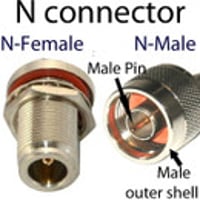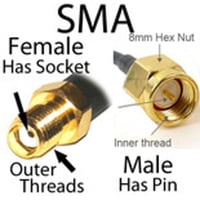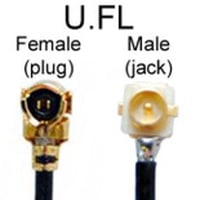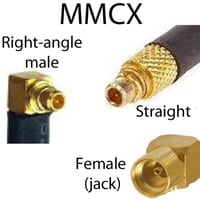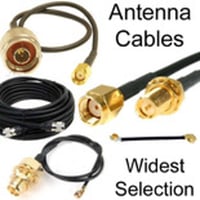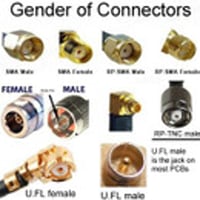N to MMCX Cables
N-Type Connector to MMCX: Antenna Cables
The MMCX connector
The Micro-Miniature CoaXial Connector (MMCX) is a micro-miniature radio frequency connector that was developed by Huber and Suhner in the 1980s. It is particularly noted for its robustness and reliability, with a snap-lock mechanism that withstands hundreds of mating cycles.
It is a miniaturized version of the MCX connector, itself an adaptation of the SMB connector, with a 35% size and weight reduction that makes it useful in applications that are component-dense or require a low footprint of the connector used.
MMCX connector physical features
- EU specification CECC 22000
- MMCX plug and jack diameter of 2.4 millimeters (0.09 inches)
- Mated height of 5.2mm
- Snap-on mating mechanism: snap ring carried by the male (plug) MMCX connector
- Force required to engage and disengage the connector: 6 Newtons maximum
- Center contact retention:10 Newtons.
- 360-degree rotation of the mated connector around its axis.
- MMCX jack and plug are made from brass with a Teflon insulator
- Male MMCX connector: gold-plated brass center pin
- Female MMCX connector: gold-plated complimentary beryllium copper receptacle.
Electrical characteristics of the MMCX connector
- Broadband radio frequency connector
- Maximum frequency: up to 6 GHz
- Nominal impedance: 50 Ohms.
- Max voltage: 170 Volts
- VSWR: 1.25:1 at 6 GHz
- Insulation resistance: 1,000 Megohms.
- Dielectric withstanding voltage of the connector is 500 Volts.
- The contact resistance: 5 milliohms
- RF leakage for the MMCX connector: -60 dB at 2.5 GHz.
MMCX connector applications
The small diameter of the MMCX is useful for scaling down wireless networking hardware and increasing its efficiency. The MMCX snaps easily onto the jack of a router board or mini PCI card and will snap off as and when needed. This means that its use is widespread in a range of wireless devices and radio components including:
- Computer peripheral devices
- Wireless internet TV
- External GPS antennas
- Wireless audio
- In-ear monitors
- GPS and PDA receivers
- Wi-Fi mini PCI cards and
- Video transmitters for First Person View
Cable for the MMCX connector
MMCX pigtail adapters use high-quality, low-loss, and flexible mini-coax to run between the micro-miniature connector and the medium-sized N connector. Quality MMCX to N connector pigtail adapters use LMR 100 or equivalent cable. Here are the specifications of LMR 100:
Physical specifications of LMR 100
- Semi-rigid, low-loss coaxial cable with double shielding.
- Bare copper-clad steel (BCCS) center conductor with a diameter of 0.018 inches (0.46mm)
- Solid polyethylene (PE) dielectric with a diameter of 0.06 inches (1.52mm)
- Unbonded aluminum tape outer conductor
- Tinned copper outer braiding with a diameter of 0.083 inches (2.11mm)
- Plastic outer jacket - total diameter of LMR 100 to 0.11 inches or (2.79mm)
- Bend radius of 0.25 inches (6.24mm)
Electrical specifications of LMR 100
- Nominal impedance: 50 Ohms
- Capacitance: 30.8 pF/ft (100.1pF/m)
- Inductance: 0.077uH/ft (0.25 uH/m).
- Velocity of propagation (Vp): 66%.
- Shielding effectiveness: more than 90 decibels
- Maximum voltage: 500 volts.
Type N connector
The size and ruggedness of an N-connector make it useful for outdoor applications, so radio devices that are primarily used or installed outdoors use this connector. When used in a pigtail adapter with the MCX or MMCX connector, the N connector can be used to connect a larger antenna to a PCB-mounted MMCX connector. This is because the N connector is more rugged, easier to handle, and will withstand repeated mating.Here are the Type N connector specifications:
Physical specifications of the N connector
- Threaded medium-size connector
- 5/8 - 24 pitched UNEF threading
- Mates by screw coupling; rated for 500+ mating cycles
- Material: nickel-plated brass or stainless steel
- Male N connector: diameter of 0.800 inches (20.3 millimeters) with internalized threads and hex nut
- Female N connector: diameter of 0.620 inches (15.7 millimeters)with externalized threads
- O-ring seal achieves an IP 67 rating, making the connection dust and moisture-free
- Standard N connectors do not have a dielectric
Electrical specifications of the N connector
- Nominal impedance: 50 ohms
- Maximum frequency: up to 11 GHz
- Peak voltage rating: 1500 volts
- Dielectric withstanding voltage: up to 2500 volts.
- VSWR of 1.3.
- Contact resistance: 1 milliohm
- Insertion loss: 0.15 dB.
- Radio frequency leakage: -90 decibels at 3GHz.

